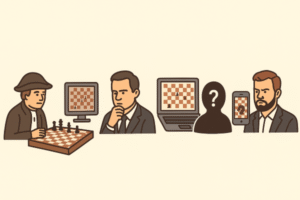The history of cheating in chess
♟️ The History of Cheating in Chess: From Hidden Hints to Digital Scandals
Chess has always been considered a “game of honest minds.” There is no luck here — only logic, calculation, and strategy. Yet even in this world of intellect, some have sought unfair paths to victory. The history of chess cheating is the evolution of deception — from subtle signals and glances to high-tech methods of the 21st century.

♜ 1. The First Cases of Over-the-Board Deception
As early as the 19th century, when tournaments were just gaining popularity, the first tricksters appeared.
Some players tried to distract their opponents, whisper to coaches, or even use mirrors to spy on moves.
A famous case involved a 19th-century German master who secretly received hints from a friend in the audience. This was the moment when organizers first began enforcing behavioral rules and isolating players during matches.
⚙️ 2. Mechanical and “Magical” Tricks
One of the most famous early examples of deception was the 18th-century “Mechanical Turk”.
This supposedly mechanical robot defeated the best players in Europe — until it was revealed that a real person was hiding inside!
Although it was more of a spectacle than a true competition scam, the “Turk” became a symbol that chess was not always as pure as it seemed.
💻 3. The Computer Era and Online Cheating
The arrival of computers changed everything. In 1997, Garry Kasparov lost to Deep Blue — and from that moment on, machines became inseparable from chess.
But along with progress came a new threat: engine-assisted cheating.
Players began using programs such as Stockfish or Komodo during games — especially in online tournaments.
⚠️ 4. Scandals of the 21st Century
The most notorious case involved Hans Niemann and Magnus Carlsen.
In 2022, Carlsen accused the young American of unfair play.
An investigation by Chess.com revealed that Niemann had indeed used computer assistance in online games, though proving over-the-board cheating was impossible.
After this, chess federations began implementing anti-cheating systems — scanners, metal detectors, and complete player isolation during matches.
🔒 5. Fighting Back: How Chess Is Protected Today
Modern tournaments resemble airport security:
- Players are checked for electronic devices;
- No one can leave the playing hall without supervision;
- Spectators and coaches are kept in separate rooms;
- Online platforms (Chess.com, Lichess,Checkmat) use AI to analyze suspicious move patterns.
Today, every game is under technological control — all to preserve the essence of fair play.
🧠 6. Why Do People Still Cheat?
Paradoxically, chess players are among the smartest individuals — yet some still take the risk.
The reasons vary:
- the desire for fame and quick success;
- pressure from sponsors and public expectations;
- the thrill of competition and the urge to prove superiority at any cost.
But the result is always the same — a ruined reputation. In chess, honor matters more than victory.
🏁 Conclusion: The Game of Minds Must Remain Fair
The history of chess cheating is a story of temptation and technology.
Every new tool brings new opportunities — and new ways to deceive.
Yet one thing never changes: true mastery cannot be faked.
A real chess player wins through thought, character, and respect for the game — not tricks.
💡 Final Thought
In chess, you may deceive your opponent once — but never fate.
The true king is the one who wins with integrity.